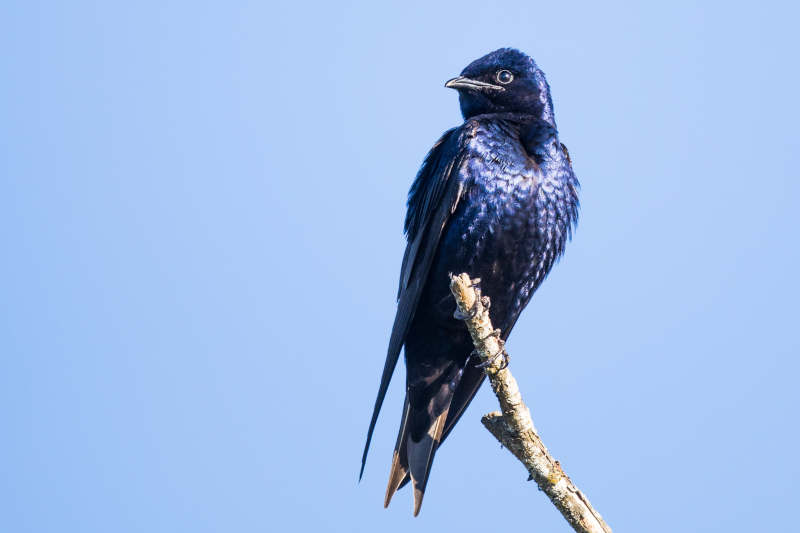Purple martins are an extremely interesting species. It is one of the only animals that I am aware of that relies on humans for its survival. However, if you have purple martins arriving at your purple martin house, you may be wondering: how long do I have to wait before the purple martins will begin laying eggs?
The purple martins will begin laying eggs between six and ten weeks after first arriving at their final destination. They spend three to four weeks forming pair bonds and establishing where they will nest, another three to four weeks building a nest before laying eggs.
So, as a landlord, how can you better predict when the purple martins will exactly lay their eggs? We can look into this so that you have a better idea.

Step 1: Begin Logging Your Findings
My advice for any purple martin landlord is to begin logging what you witness. You may have some purple martins, known as scouts, arriving early on in the season. They will come and go for a bit of time before landing at their final destination. It is worth noting that once the scouts arrive, there may be a couple of weeks later that the younger males and females arrive as well. This is the start of the clock, generally.
In years past, my attempt to logging was done on a sheet of paper. In most recent years though, I have found having my phone out with a Google Spreadsheet open is best. I have the following columns: date, males, females, unit #, total, comment
The comment section is where I place any details the condition of their units. If I witness any mites, mold, or other issues. In addition, I write whether I believe pairs have been formed, and just a short little comment about the status of their unit as a whole. I use the “Unit #” column to keep track of each unit individually if there is anything that needs to be specified. Early in the season, there may not be any difference between each unit.
Once you begin to see the males stick around for a period of time and the females arrive, you are very likely to see the pairs beginning to form. The males may be a little bit more territorial of the units and may try to claim more than one initially. However, once the pairs are confirmed, you will notice the colony feeling a bit more calm.
As a landlord, you want to log your findings as you check on the colony. How many purple martins do you see? Are the males or females? If you see spots on the chest of the purple martin, it may likely be a young male, so be careful with making the distinction. You are going to make a few wrong assumptions from time to time, and that’s okay.
Step 2: The Pairs are Formed
You should begin noticing pairs being formed. They may often sleep in the same compartments and generally the males have marked their territory. They are notorious though for not being truly faithful, so you may still see them lurking around other sexes too. However, pairs are generally formed within a few weeks of the males and females both having arrived.
Step 3: The Pairs Begin Building a Nest
You know for sure that the pairs have been formed when you check on your purple martin house and the nests are being built. Some of the pairs will build mud dams that we believe are attempts to keep water out of their nests. Some will create them, some will not. You will notice that more twigs, hay, and pine needles are beginning to be collected within the purple martin house units.
The process of building a purple martin nest may take three to four weeks. The nest takes quite some time and generally will be built of brown materials. This is worth noting because the next step may indicate that eggs are coming very soon. In addition, as you watch the nest being built, consider logging the depth of the nest. The nests are typically one to three inches in depth.
Step 4: Green Leaves Appear
Once the nest has been built, there will be a time that most purple martins will bring in green leaves. If you see green leaves on top of the nest, this is a good indication that eggs may arrive soon. According to the Purple Martin Conservation Association, there is no knowledge of why the purple martin places green leaves as a layer between their nest and the eggs. It may be due to insulation or some form of protection from any small harmful critters hiding in the nest itself.
Step 5: Eggs Begin Arriving!
Within as little as a couple of days after the leaves begin appearing you can expect to see eggs being laid. Female purple martins will begin laying one egg every day in the early morning hours.
This means as a landlord, you will not be disruptive by checking daily on the eggs as they begin to arrive. You can expect typically around six eggs, four is a small amount and eight is a large amount.
At this point, I recommend each landlord to continue checking on the eggs daily. There are predators that would love to get access to those eggs. You want to log how many you have daily and in each compartment. This is to ensure that nothing is happening to the amount that you have. You also want to ensure no damage is being done to them.
There is a myth that if you touch the eggs or move them in any way that the birds will not return. While I would recommend being careful with them and not handling them unless needed, I wouldn’t hesitate to move any that appear out of place or may have been moved from raising or lowering your purple martin house or gourds. The purple martins will return without a problem, and likely welcome the help!
Conclusion
I highly recommend that you keep track of your purple martins with some form of log. In my case, I simply use a spreadsheet on Google Drive that helps me keep the date and what I witness. I try to always keep track of the number of martins I am seeing. I attempt to determine whether they are male or female and write this number down as well. This helps me determine when I may begin seeing eggs.
Keep in mind that weather is sometimes a factor too for when you begin seeing eggs arrive. If you have had a winter that has lasted late into the season, you may see the purple martins a bit slower to build their nests and begin laying eggs.
